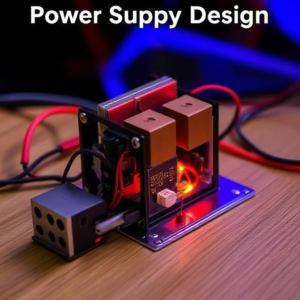Power Supply Design:
Power supply design is about creating a system that provides the right amount of power (voltage and current) to run electrical devices, like computers, gadgets, or motors.

- What’s the purpose?
The power supply takes power from a source (like a wall outlet or battery) and converts it into a form that’s usable by the device. For example, many devices need 5V or 12V, but the wall outlet gives 120V (in the US) or 230V (in other countries). The power supply “transforms” this high voltage into a lower one that the device can safely use. - Key parts of a power supply design:
- Transformer: In many designs, a transformer steps down the voltage (e.g., from 120V to 12V).
- Rectifier: It converts alternating current (AC) from the power source into direct current (DC), which most electronic devices need.
- Filter: It smooths out the fluctuations in the DC power to make it steady.
- Regulator: This part ensures that the voltage stays constant, even if the power supply’s input voltage or load changes.
- Why is power supply design important? A good power supply provides clean, stable, and reliable power. If the power is too high or too low, or if it fluctuates too much, the device may not work properly or could even be damaged.
Power Supply Regulation:
Power supply regulation ensures that the output voltage remains steady and within a specific range, even when conditions change.
- Why is regulation needed? Electrical devices usually require a consistent voltage to function correctly. For example, a computer might need exactly 5V to work, but if the voltage changes, the computer could malfunction or even break. Regulation makes sure the voltage doesn’t go higher or lower than what’s needed.
- How does regulation work? A voltage regulator automatically adjusts the output voltage to keep it stable, even if:
- The input voltage (from the power source) changes.
- The current draw (how much power the device is using) changes.
Think of it like a thermostat in your house. If the temperature in your house drops too low, the thermostat turns the heater on. If the temperature gets too high, it turns the heater off. Similarly, a voltage regulator adjusts the power to maintain the right output voltage.
- Types of Regulation:
- Linear Regulators: These are simple, but they are less efficient because they burn off extra power as heat. For example, if the input is 12V and the device needs 5V, the regulator reduces the excess power (7V) as heat.
- Switching Regulators: These are more efficient. They use a different method to convert power (by rapidly switching on and off), which wastes less energy and doesn’t produce as much heat.
Putting It All Together:
Imagine you have a phone that charges using a wall charger:
- Power supply design takes the 120V (AC) from the wall outlet, steps it down to 5V (DC), and sends it to the phone.
- Regulation makes sure that the 5V is stable, so the phone doesn’t get damaged or overcharged.
If the power supply wasn’t regulated, and the voltage fluctuated, it could cause the phone to charge too fast (which could damage the battery) or too slow (which could prevent it from charging properly).
Summary:
- Power Supply Design is about creating a system that converts and delivers the right amount of power to a device.
- Power Supply Regulation ensures that the voltage stays steady and safe for the device, even when there are changes in the power source or the device’s power demand.
Power supplies and regulation are crucial for keeping electronic devices working properly and safely.
Tags: AC to DC conversion, battery, Circuits, clean power, current, current draw changes, device protection, device safety, Efficiency, electrical devices, Electronics, filter, Heat Dissipation, input voltage variation, Linear Regulators, power conversion, power fluctuations, power source, power stability, Power Supply Design, power supply regulation, rectifier, regulator, reliable power, stable voltage, switching regulators., Transformer, voltage, voltage regulation, voltage regulator, voltage smoothing, voltage transformation, wall outlet

